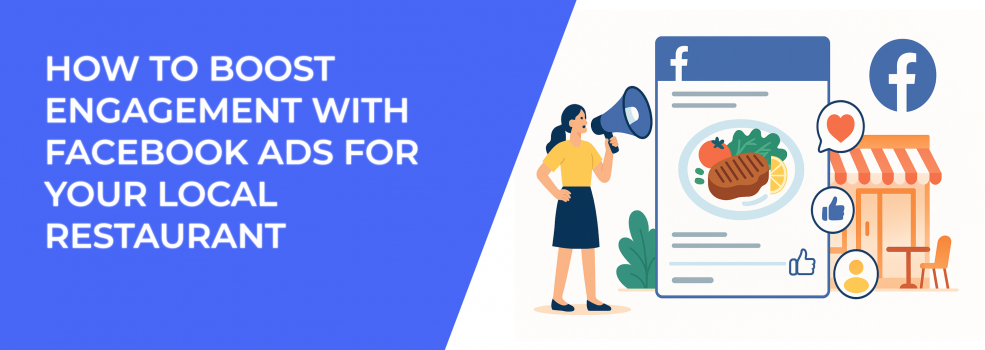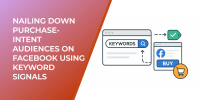Running a local restaurant today means juggling a lot — keeping regulars happy, attracting new faces, and standing out in a crowded market. You’ve got great food and a solid vibe, but if people nearby aren’t finding you online, you’re missing out.
That’s where Facebook and Instagram ads can make a real difference. They let you reach the right people, close to your location, and turn scrolling into real visits. But just putting up an ad doesn’t do much on its own. You need to be thoughtful about what you say, how you say it, and who sees it.
In this guide, we’ll walk through what works right now for local restaurants using Facebook Ads — and how you can use simple but smart strategies to get more engagement, more clicks, and more people walking through the door.
Know your audience
efore you spend anything on Facebook Ads, ask yourself: who are you really trying to reach?
It might seem smart to target “everyone nearby,” but that’s rarely effective. A college student ordering late-night takeout isn’t looking for the same experience as a parent planning a weeknight family dinner. The better you define your audience, the better your ads will work.
Start by thinking through a few key customer types, such as:
-
Young professionals who care about great ambiance and craft cocktails;
-
Families searching for easy, casual, kid-friendly meals;
-
Out-of-town visitors who want to try authentic local food.
Once you’ve outlined who you're talking to, Facebook gives you flexible tools to reach them. Use location targeting to focus your ads within a few miles of your restaurant — that’s often the sweet spot for foot traffic and delivery. You can also apply demographics like age or household status and layer in interests such as “brunch,” “local food,” “live music,” or “date night.”
If you're targeting larger cities or regions, like “New York City” or “Florida”, you’ll sometimes see an extra option in Ads Manager: Reach more people likely to respond to your ads. This lets Facebook show your ad to people who:
-
Have recently visited or lived in the selected city or region;
-
Searched for related places or listings;
-
Interacted with local Pages or events;
-
Have friends in the area or live nearby.
This feature can help restaurants get in front of people who are planning a trip, looking for a spot to eat during a visit, or just browsing for local food experiences. In many cases, advertisers have seen lower costs per result using this expanded targeting.
So if you're in a city that draws tourists or travelers — or even just day-trippers — this is worth testing. But if your goal is to strictly target locals, you can simply uncheck the feature.
And for those curious about digging deeper into how to build smart audience personas, this guide on creating persona-driven targeting strategies is a great next step.
The takeaway? The more relevant your ad is to the person seeing it, the more it feels natural — like something they were already looking for.
Create ads that don’t look like ads
People scroll through Facebook and Instagram to catch up on life, not to see ads. If your post feels too much like a billboard, it’ll get ignored fast. But if it looks like something real — something interesting — it has a much better shot.
So what works? Real photos over overly polished ones. Think of:
-
A warm, close-up shot of your best-selling dish;
-
A picture of friends raising drinks at a full table;
-
A peek inside your dining room during a busy evening;
-
A customer post you’ve re-shared that shows off their plate.
Try to make your ads feel personal and local. Your copy should match — simple, fun, and human. Instead of saying “Come try our signature burger,” you could write, “Craving something stacked and cheesy? We’ve got you.”
At the end, include a clear call to action: “Reserve a table,” “Order now,” “Check our menu.” It should be easy to click, easy to understand, and matched to what your audience needs at that moment.
Your ad doesn’t need to shout. It just needs to feel like something they’d stop to look at.
Need help with your copywriting? This breakdown on writing ad copy that converts shows how to keep things short, smart, and scroll-stopping.
Use video to show what it’s like to be there
Photos are good. Video is better. Especially for restaurants.
Short videos give people a feel for what your food, space, and vibe are like — and they do it fast. On Instagram and Facebook, videos often perform better than photos, especially when used in Stories or Reels.
You don’t need to overproduce. A phone with good lighting and steady hands will do. Try things like:
-
A timelapse of a busy kitchen or full dining room;
-
A short clip of a dish being prepared and served;
-
A look at your staff putting together a special;
-
A fun reaction from a happy customer trying your dessert.
Keep it quick — 15 to 30 seconds — and use subtitles or on-screen text since most people scroll without sound. Show your logo or restaurant name early in the video, but keep it subtle.
Also, try using different formats: square or vertical usually work better than horizontal. And once you’ve made a few, test them to see which one gets more engagement. The ones that get people to watch and click? Run those more often.
Want more ideas for engaging video content? Take a look at this guide to reviving cold traffic with video ads — it’s packed with short-form formats that perform well for restaurants.
Don’t let interested people slip away — retarget them
Some people who see your ad might click to check out your menu — and then get distracted. Or maybe they watched your video but didn’t follow through. That doesn’t mean they’re not interested — it just means the timing wasn’t right.
You can set up retargeting ads to reach these people again. Facebook lets you build audiences from users who:
-
Visited your website but didn’t take action;
-
Watched a certain amount of your video;
-
Clicked on an ad but didn’t place an order;
-
Engaged with your Instagram or Facebook page.
Then, show them a follow-up ad that’s a little more specific. Maybe it highlights your happy hour, your new lunch special, or a time-limited offer. These people already know about your restaurant — they just need a reason to come back to it.
Use these follow-ups to be helpful, not pushy. Remind people why they were interested in the first place.
Keep an eye on how often they’re seeing your ads, too. You don’t want to overwhelm them. Just stay visible enough that when they are ready to eat out, your place comes to mind first.
For a deeper dive into retargeting strategies that actually convert, take a look at this walkthrough on how to re-engage cold audiences using Facebook Ad targeting.
Run ads at the right times and on the right placements
When you show your ad matters just as much as what it says. If your ad pops up at midnight when no one’s thinking about dinner, it won’t do much.
Use Facebook’s ad scheduling tools to set your ads to run during the hours when people are deciding where to eat. That usually means:
-
Around lunchtime (11 a.m. to 1 p.m.);
-
Late afternoon (4 p.m. to 6 p.m.) when people start thinking about dinner;
-
Weekend mornings (9 a.m. to 12 p.m.) if you serve brunch.
Also, pay attention to local events, weather, or patterns. Is rain in the forecast? Push delivery options. Is a nearby event expected to bring in crowds? Promote a pre-event menu or a quick turnaround dinner.
Let Facebook automatically place your ads across Instagram, Facebook Feed, Stories, and Messenger. Then check performance and adjust. You might find that Reels do better than Feed posts — or that Stories are your sweet spot for specials.
Smart scheduling and placement help you get in front of people right when they’re ready to eat — not just when your budget says to run.
Not sure where your ads should show up? This article on ad placement choices breaks down what works best based on campaign goals and format.
Focus on real results
A lot of businesses look at likes and views and think that means success. But for a local restaurant, you need to focus on what leads to actual results.
Track things like:
-
Cost per click (how much you pay to get someone to your site);
-
Click-through rate (what percent of people actually clicked the ad);
-
Conversions (how many placed an order, made a reservation, or called);
-
Comments and shares (which show whether your content sparked real interest).
If you can, connect your online ordering or reservation system to your Facebook ads using the Pixel or Conversions API. That way, you can track what ads actually brought people in.
Test different messages and visuals often. Don’t assume that just because one ad did well last month, it’ll work again now. Facebook Ads are easy to adjust — which makes it easy to improve as you go.
Ask yourself often: is this ad helping me get more diners? If not, it’s time to try something different.
Wrapping it up
Facebook Ads aren’t just for big chains or flashy startups. For local restaurants, they’re one of the best tools to connect with nearby people and build lasting visibility.
The key is to stay local, stay personal, and stay flexible. When you understand your audience, show them something worth their time, and keep your message clear, the results start to build up — more clicks, more conversations, and more people walking through your door.

